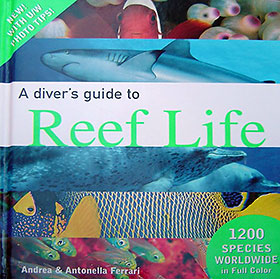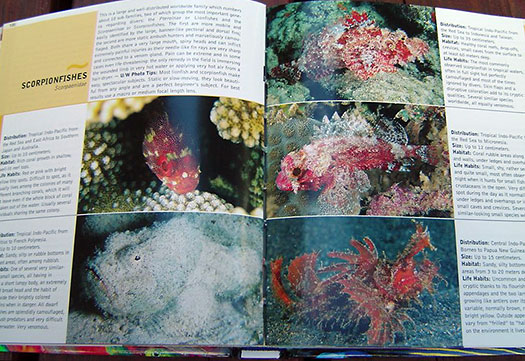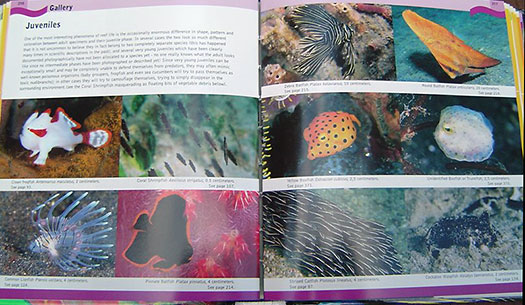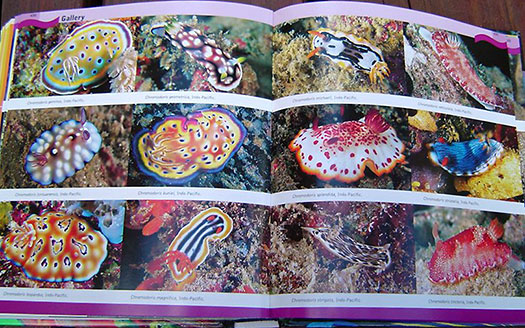A Diver’s Guide to Reef Life by Andrea and Antonella Ferrari

Andrea and Antonella Ferrari are busy, busy people. Based in Italy, Andrea is a film critic and Antonella works as a technical printing adviser for a publishing company. However, they also write and publish wildlife books on the side. In the 1990s, they began publishing books about terrestrial animals. Soon after, however, they quickly turned their pens and cameras to the undersea world. In the last nine years, the couple has produced 7 books ranging from a guidebook detailing Malaysian dive resorts to Oceani Segreti, a stunning coffee-table book awarded the World Grand Prize at the Underwater Image Festival at Antibes. Currently, the couple also serves as associate editors for FiNS dive magazine.
The mind boggles, therefore, thinking about where the Ferraris found the time to write and (self-)publish A Diver’s Guide to Reef Life, an amazing 478-page reference guide detailing 1200 tropical species—from the Caribbean to the Indo-Pacific—that divers might encounter. With over 1300 sensational, eye-popping photos, the book covers everything from corals to mammals, from reptiles to bony fish. More than just a photo album with lots of pretty pictures, though, the Ferraris appeal to their left-brained readers, as well. Clearly expert at everything below the waves, they write with as much authority on the skeletal components of coral polyps, for example, as they do on a shark’s countershading. If you can rip yourself away from their cool, crazy kaleidoscope of images, you’ll find the engaging text to thoroughly—yet clearly and concisely—explain how cnidoblasts inject their nematocysts; what influences a coral colony’s structure; and how calcareous spicules support soft corals. Don’t worry if you don’t know all the jargon before you crack the spine of this fabulous book. The Ferraris explain everything, and after spending a few minutes with A Diver’s Guide, you’ll understand plenty.

After a brief introduction that explains what a coral reef is and how you can protect it, the book sinks its teeth into Chondorichthyes—cartilagionous fishes that include sharks and rays. Throughout the book, each creature profiled gets a snapshot and, right next to it, a detailed description that includes distribution, size, habitat, and “life habits”—a summary of the animal’s characteristics that may include color variations or other useful tid-bits. Thoughtfully, the Ferraris also provide underwater photo tips specific to many of the families, so you can come home with photos as brilliant as those in the book. (Don’t get your hopes up!) After cartilagionous fishes, the Ferraris detail bony fishes, crustaceans, cephalopods, reptiles, and mammals. They even cover the “topside reef” and discuss some of the animals lurking along the sandy shoreline outside your dive lodge. Not to repeat myself, but the photos throughout the book are absolutely mesmerizing. Some of my favorite images include the Pajama Cardinalfish; the Gold-Spec Jawfish; the Bridled Burrfish; and the Broadclub Cuttlefish. Nothing, however, can touch that blood-red scorpionfish on page 133. Wow. Really. Wow!

I guess they had so much extra time on their hands that the Ferraris decided to throw in some bonus sections, as well—which really helps A Diver’s Guide stand out from the crowd. One of the sections, for example—“Zoom”—spotlights a general group of animals, or a certain technique that groups of animals have adopted (think: camouflage or schooling). Other sections—the “Galleries”—are fan-tabulous photo essays featuring, for example, hard corals, sponges, sea squirts, sea shells, flatworms, nudibranchs, and the super-intriguing “Strange Reef Creatures.” (Be sure to check out the “sailor’s eyeball”!). These Galleries strip away the textual descriptions of the animals and provide luscious eye-candy showcasing the color variations found among species (I LOVED the scorpionfish headshots!). The colors are so rich and the details are so amazing in these photos, that you’ll wonder if this is a taxonomic guide or an underwater photography how-to. Oh…that’s right…it’s both!

Speaking of photography, underwater photographers will find A Diver’s Guide useful for several reasons. First, as mentioned, the photo tips the Ferraris include should help divers increase the quality and size of their personal portfolios. Second, even only a few minutes with the book will provide the underwater photographer with an understanding of what kind of marine life is likely to be found in a given location. This doesn’t just mean “in the Red Sea,” though; since the Ferraris provide information about where on the reef an animal is likely to be, a person unfamiliar with—but in need of—a particular creature could focus his or her search during a dive. Third, A Diver’s Guide will help photographers label their images correctly. (After all, no one wants to submit a photo to, say, the Wetpixel/DivePhotoGuide International Photo & Video Competition and have it mis-captioned!) Finally, some of the tips—while not directly related to imaging—may be wise for the underwater photographer to bear in mind anyway. For example, the inexperienced photographer might be less inclined to wag a finger in front of an uncooperative pufferfish after reading that they “are quite capable of severing a human finger.”
The book also features two indices—one for common names, and one for scientific names. This way, if the show-off on the liveaboard is bragging that he saw an Achaeus japonicus, you can look it up and know that he saw the same Orangutan Crab you did! Unfortunately, you’ll probably have to wait until you get back to your room to confirm this fact. The only problem with this book is that the pages aren’t laminated. In other words, A Diver’s Guide probably won’t be making too many appearances on the decks of boats, in the vicinity of wet fingers.
Inevitably, readers will compare A Diver’s Guide to Paul Humann’s Reef Fish books. While they’re similar in many respects, I think A Diver’s Guide is far more beautiful. I’ve flipped through Humann’s books on many occasions, looking for something specific, and I closed the book when I found what I needed. Conversely, the Ferraris have produced a guidebook that’s as much for browsing as it is for referencing. As proof, I submit to you my non-diving wife. As soon as she saw the book on the counter, she grabbed it, sat down, and began leafing through it. Every 20 seconds or so, she’d mutter, “Oooh, have you ever seen a [insert name of fish] before?” She was totally rapt by the images. And you will be, too.
A Diver’s Guide to Reef Life will be available on SeaChallengers.com and Amazon.com in the next few weeks. Expect it to cost around $55. Sure, you could buy a local marine life guide covering the specific area you might be diving next Christmas, but no marine guide in the world will excite you with this much color, thrill you with this much variety, and fascinate you with this much information. This is an absolute must-have for any diver who has eyes and plans on using them while diving.